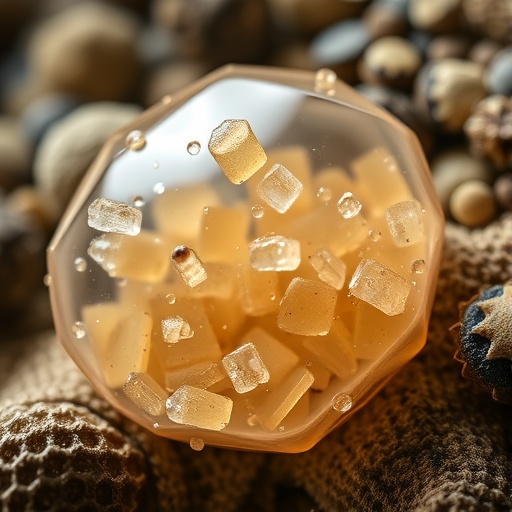In a groundbreaking study that bridges terrestrial geochemistry with planetary science, researchers have unveiled new insights into how sulfates form in oxygen-rich yet acidic environments heavily influenced by microbial activity. Focusing on the ancient mining district around Spain’s Rio Tinto River, a notoriously contaminated and oxidized watershed, the team has deciphered complex isotopic signatures locked within sulfate minerals—signatures that could open new avenues for understanding Earth’s early atmosphere as well as Mars’ geological past.
The Rio Tinto basin is a unique natural laboratory that simulates conditions thought to resemble ancient Martian surface environments. Here, iron- and sulfate-rich waters, stained vivid red and green due to oxidized iron species, flow alongside intense microbial ecosystems adept at driving sulfur and iron chemical transformations. By employing precise measurements of triple oxygen isotopes—ratios involving oxygen isotopes 16, 17, and 18—in sulfate minerals, the researchers sought to unravel the proportional contribution of atmospheric oxygen versus water-derived oxygen during sulfate formation under the influence of pyrite oxidation.
Pyrite, commonly known as fool’s gold, plays a pivotal role in this geochemical theater. When exposed to oxygen, especially in environments abundant in acidophilic microorganisms, pyrite undergoes oxidative dissolution, releasing sulfate ions into the surrounding fluid. The presence of microbes such as Acidithiobacillus ferrooxidans, considered one of Earth’s earliest chemoautotrophic life forms, profoundly impacts this rate and nature of oxidation by bioleaching pyrite directly with molecular oxygen. Remarkably, this process preserves an extraordinary fraction—exceeding 80 to 90 percent—of the atmospheric oxygen isotopic signature within the resultant sulfate.
This discovery marks the first real-world demonstration outside laboratory constraints that direct interaction between pyrite sulfur and molecular oxygen can be sustained under natural environmental conditions, provided a microbe-rich acidic ecosystem is present. Previous experiments had shown that sulfate oxidation signatures degrade rapidly when oxygen from water mixes in; however, Rio Tinto’s ongoing bioleaching maintains a robust isotope imprint from the atmosphere. The implications are profound, indicating that sulfate minerals can encapsulate not only geochemical records of Earth’s atmospheric evolution but also microbial biosignatures that signal life’s influence on geochemical cycles.
Sulfate minerals are of critical interest in astrobiology because of their chemical stability and ability to preserve oxygen isotopes over geological timescales. These ancient minerals function like time capsules, retaining fingerprints of atmospheric oxygen levels from billions of years ago. Applying this understanding to Martian environments, which host extensive sulfate deposits, could shed light on past atmospheric conditions and potential microbial activity. However, deciphering their origin remains a challenge. Scientists have traditionally posited that Martian sulfates primarily formed via atmospheric oxidation of volcanic sulfur dioxide aerosols without biological influence, but localized acidic, oxygen-rich niches may have existed where biology-like processes were possible.
The team’s isotopic approach offers a powerful tool for parsing Martian sulfate genesis. By quantifying triple oxygen isotope ratios, researchers can identify whether sulfates directly incorporated atmospheric oxygen, intestinal oxygen from water, or other sources. This isotopic “fingerprinting” could help distinguish sulfate deposits formed through abiotic atmospheric chemistry from those potentially shaped by microbial processes or water-rock interactions similar to those at Rio Tinto. Such distinctions will become increasingly vital as NASA’s Curiosity and Perseverance rovers continue collecting Martian samples that may one day be brought back to Earth for detailed laboratory examination.
Despite this promising methodology, significant hurdles remain before unequivocal identification of microbial biosignatures on Mars is possible. Samples must originate from highly acidic, oxygen-oxidation-dominant environments rich in ferrous iron ions (Fe2+), conditions resembling Rio Tinto’s distinctive ecology. This reality highlights the critical need to contextualize isotopic data with mineralogical and geochemical environmental indicators. Moreover, assumptions about ancient atmospheres’ oxygen levels need careful calibration to accurately reconstruct formation conditions from isotopic signals.
The study spearheaded by University of Utah geochemist Issaku Kohl integrates field observations with sophisticated isotopic analyses. Kohl emphasizes the importance of recognizing environmental niches where microbial bioleaching actively directs sulfate formation, suggesting that these signatures can survive over geologic timescales. This opens new research horizons not only for understanding early Earth ecosystems when oxygen began accumulating in the atmosphere but also for extrapolating potential biosignatures in extraterrestrial geological records.
By revealing that microbial communities exert a discernible influence on sulfate isotope compositions in natural environments, this research challenges previous paradigms primarily derived from laboratory studies and abiotic models. The Rio Tinto site exemplifies how life and geochemical processes intricately intertwine to shape the mineralogical and isotopic landscape, providing a living analog for planetary environments beyond Earth.
The researchers acknowledge that while these findings advance the search for life’s traces beyond our planet, they also underscore the complexity inherent in interpreting isotopic data from ancient rocks. Extricating biotic signals from abiotic backgrounds demands multidisciplinary approaches integrating microbiology, geochemistry, and planetary science. Nevertheless, the Rio Tinto analog and isotope framework developed in this study provide a robust foundation for future astrobiological missions and Earth system paleoenvironmental reconstructions.
Looking ahead, this pioneering work highlights the critical role of field experiments and natural system observations in refining models of mineral formation and isotopic fractionation. As sample return missions from Mars progress and terrestrial analog research continues, scientists will be better equipped to decode the nuanced interplay of life, atmosphere, and geology in shaping sulfate minerals—both on our home planet and in the broader cosmos. Such breakthroughs not only deepen our understanding of Earth’s formative years but also inch us closer to answering humanity’s most profound question: Is there life beyond Earth?
Subject of Research: Geochemistry and astrobiology study of triple oxygen isotopes in sulfate minerals formed by bioleaching of pyrite.
Article Title: Triple-oxygen isotopic evidence of prolonged direct bioleaching of pyrite with O2
News Publication Date: September 30, 2025
Web References:
- Earth and Planetary Science Letters Article
- DOI Link
- NASA Astrobiology Institute
- Mars 2020 Perseverance Mission
References: Issaku Kohl et al., Earth and Planetary Science Letters, 2025.
Image Credits: Issaku Kohl, University of Utah
Keywords: Geochemistry, Pyrite, Sulfates, Mars, Oxygen




